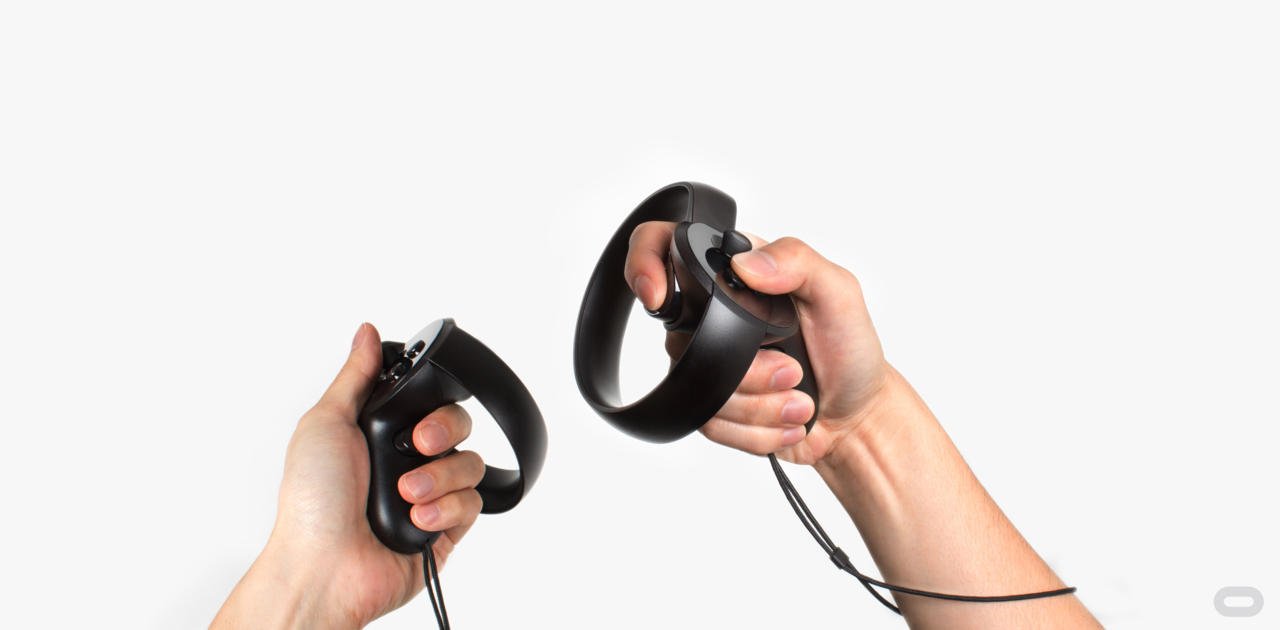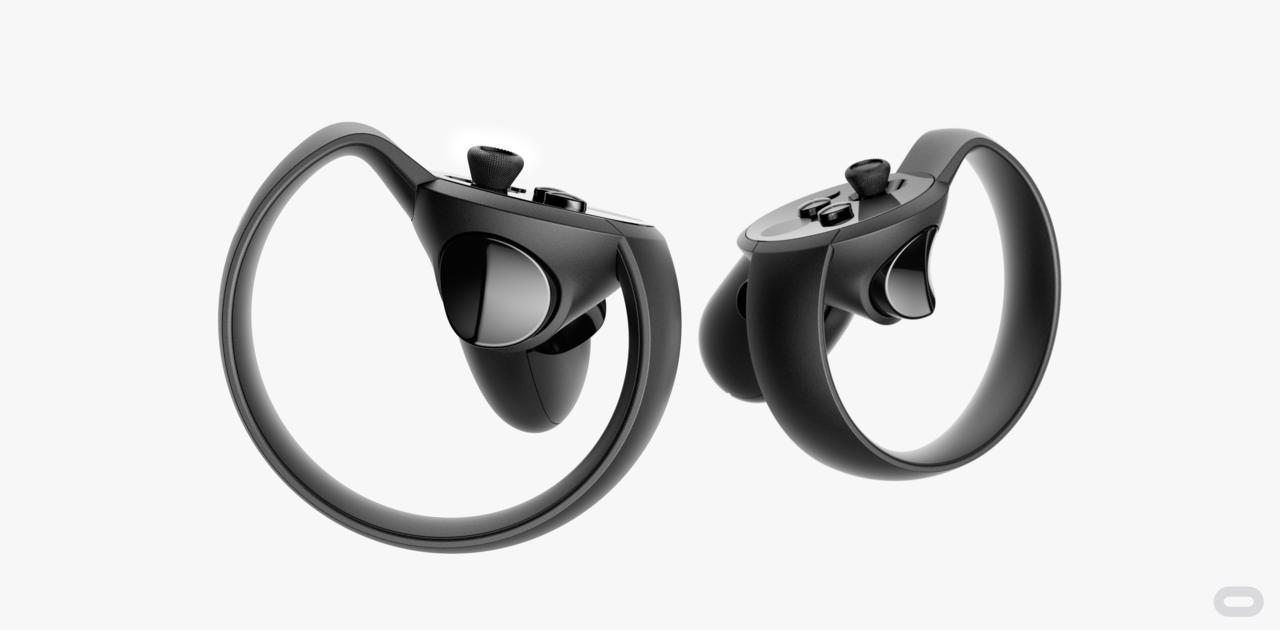Oculus Rift was a good VR headset when it launched in March, but its tech was overshadowed by the HTC Vive. Released hot on its heels, HTC’s VR system offered 1:1 motion tracked controllers and a more immersive room-scale experience. Oculus Touch is the company's attempt to bridge the gap. The controllers bring your hands into VR with the same level of precision as the Vive controllers. It’s not cheap at $199, but it is worth it.
What’s Inside the Box?
For $199, you get two controllers tailored for each hand. The box also includes a secondary sensor, which is identical to the one that comes bundled with the head-mounted display. The secondary sensor allows the constellation tracking system to increase its field of view. The package also comes with a dongle for Rock Band VR, which allows you to track the position of Harmonix’s plastic guitar (sold separately). Finally, the box includes two non-rechargeable AA batteries for the controllers. Unfortunately, you can’t recharge the controllers.
Design
The small controllers can be a bit confusing to hold at first, since they look bizarre and it’s not immediately clear which controller belongs to which hand. They’re also really light at 136 grams and feel really comfortable and ergonomic.

The controllers have a lot of buttons and they can seem overwhelming at first, especially since you’re effectively blindfolded from the real world in VR. It also doesn’t help that many games render virtual human hands, rather than 1:1 representations of Touch controllers. Fortunately, Oculus includes tutorials that walk you through the controller's various capabilities. These come in handy when you let newcomers try them.

The controllers also have multiple capacitive zones: the index trigger, analog stick, thumb rest, and face buttons. Oculus has also implemented a system for Touch that allows you to lift your thumb off the controller to give the thumbs-up gesture in-game. Similarly, when you lift your index finger off the trigger button, your virtual index finger will point. These movements are useful when you want to congratulate your VR buddy or point at an object.

Setup
The setup is straightforward and there’s an on-screen tutorial that walks you through the process. Unlike the Vive, which suggest you place its sensors on opposite ends of your room, the Rift recommends that you place both of its sensors roughly three to seven feet apart in front of you.
Once you’ve got everything plugged in and paired, you’ll set up Guardian. It's pretty much the same thing as SteamVR’s Chaperone system and allows you to draw a virtual boundary within your walkable space.
In the traditional setup, Oculus says that you can get a play space that measures up to 2x2 meters (6.5x6.5 feet), but there’s also an “experimental” 360 degree setup, which allows you to place one of the sensors behind you to prevent the controller from being occluded, or blocked, from the constellation tracking system. However, there are two issues with this configuration. It shrinks your play space down to 1.5x1.5 meters, but the bigger issue is that the sensor’s 8.1 foot cable isn’t long enough to go behind your back without a USB extension cable.
There’s another experimental room-scale setup that allows you to walk around a larger 2.5x2.5 meter space if you purchase a third sensor, which is sold separately for $79. For this setup, you’ll need a spare USB 2.0 port and the aforementioned USB extender so that you have enough slack to place the third sensor behind you. I tried it, and it does increase the playable boundary, but the biggest thing holding room-scale back is the headset’s relatively short cable. At about 12.5 feet, it’s too short to allow you to walk around very much and currently feels like an afterthought. This isn’t as big of an issue with the Vive, which has a cable that measures over 16 feet.
Touch in Action
I played a bunch of games to put the controllers to the test and am glad to say that they performed really well. Even with the traditional two front-facing sensor setup, the controllers rarely got obscured. The controllers would generally only occlude, or get blocked, if I turned my back towards the sensors and held them too close to my body or positioned them beneath the sensors. Tracking is also accurate. There are a lot of buttons, but once you learn the layout, it feels really natural to pick up objects, fire guns, wave at allies, and more.
Mortal Kombat 1 Homelander Official First Look Trailer Playing Fallout 4 In 2024 Firearms Expert Reacts to Helldivers 2 PART 3 What's Become Of Batman Games? | Spot On Apex Legends: Official Upheaval Gameplay Trailer SteamWorld Heist II | Gameplay Deep Dive Trailer Best Fallout 4 Mods For People That Don't Care About Settlements Honkai: Star Rail - "If We Had Wings" | Myriad Celestia Trailer Fortnite - Official Star Wars Lands Update Event Gameplay Trailer Wuthering Waves | Resonator Showcase | Lingyang — Debut LEGO Fortnite | Star Wars LEGO Pass: Rebel Adventure Official Explainer Video RKGK | Official Release Date Gameplay Trailer
Please enter your date of birth to view this video
By clicking 'enter', you agree to GameSpot's
Terms of Use and Privacy Policy
Playing the first-person shooter Dead and Buried, I could more accurately shoot enemies by looking down my pistol's sights. It’s so accurate that when I shoot basketballs in VR Sports Challenge, I can get a strong sense of whether shots will land before they even hit the backboard. Tagging artwork in Kingspray Graffiti Simulator, I could control the intensity of my spray can with Touch’s analog trigger, which offers different degrees of pressure. In creative tool Medium, I could use the controllers to sculpt objects in three-dimensional space with six degrees of movement. This is something that you simply can’t do with a standard gamepad.
Mortal Kombat 1 Homelander Official First Look Trailer Playing Fallout 4 In 2024 Firearms Expert Reacts to Helldivers 2 PART 3 What's Become Of Batman Games? | Spot On Apex Legends: Official Upheaval Gameplay Trailer SteamWorld Heist II | Gameplay Deep Dive Trailer Best Fallout 4 Mods For People That Don't Care About Settlements Honkai: Star Rail - "If We Had Wings" | Myriad Celestia Trailer Fortnite - Official Star Wars Lands Update Event Gameplay Trailer Wuthering Waves | Resonator Showcase | Lingyang — Debut LEGO Fortnite | Star Wars LEGO Pass: Rebel Adventure Official Explainer Video RKGK | Official Release Date Gameplay Trailer
Please enter your date of birth to view this video
By clicking 'enter', you agree to GameSpot's
Terms of Use and Privacy Policy
The Touch’s haptic engine is also fantastic. Playing the 1v1 wizard-dueling game The Unspoken, I could feel how powerful my charging fireballs were by how violent my controller shook.
Even though the Rift’s constellation system only tracks the position of your hands and head, it’s enough data to allow developer Sanzaru Games to build a fairly sophisticated system that tracks your entire body in their game Ripcoil. This allows your online opponent to see you crouch and even dance in the robotic tennis-like game. It’s kind of amazing.
With SteamVR
The Touch controllers don’t just open up new gameplay opportunities from the Oculus store, but on Steam as well. In its pre-release state, the Touch controllers work relatively well with motion-tracked games designed for the Vive. There are even icons for the Touch controllers in SteamVR’s menu. The biggest issue at the moment is that the Vive controllers are rendered in VR in lieu of Touch. This can be awkward and disorienting at first. It will take you a minute or two to figure out how SteamVR has remapped the buttons.
The controller’s tracking is still great in Steam titles, but there are currently a few bugs. The biggest one prevented me from setting up SteamVR’s chaperone system. I simply couldn’t draw my walkable boundary. I also couldn’t navigate through SteamVR’s menus with Touch’s joystick.
I played through Space Pirate Trainer, Trials on Tatooine, and Valve’s The Lab on Steam. Everything worked well, though the scale of Longbow in Valve’s VR compilation seemed a bit larger than it does on the Vive.
Conclusion
At $199, Oculus Touch isn’t cheap, but it gets your hands into VR and allows you to more intimately interact with your virtual environment. It makes gameplay a physical activity and induces a sense of virtual presence in a way that traditional gamepads can’t. It helps that Oculus is bundling Touch with Medium, Quill, Dead and Buried, and Toybox, which are fun motion-tracked titles.
Touch isn’t perfect, but unless you’re against a little physical exertion, it’s a must-buy for every Rift owner. It's a necessary part of the package as far as I'm concerned and feels like the missing piece of the puzzle.
